Does Increasing the Diversity of Small Grain Cropping Systems Improve Aggregate Stability and Soil Hydraulic Properties?
Abstract
1. Introduction
2. Materials and Methods
2.1. Experimental Layout
2.2. Dry Aggregate Stability (DAS)
2.3. Wet Aggregate Stability (WAS)
2.4. Water Retention Curve, Hydraulic Conductivity and Bulk Density
2.5. Soil Particle Size Analysis and Carbon Content Measurements
2.6. Statistical Analysis
3. Results
3.1. Dry Aggregate Stability
3.2. Wet Aggregate Stability
3.3. Water Retention Curve, Hydraulic Conductivity, van Genuchten Fitting Parameters and Bulk Density
3.4. Soil Carbon Concentration and Particle Size Analysis
3.5. Correlation between Soil Properties
4. Discussion
5. Conclusions
Author Contributions
Funding
Data Availability Statement
Acknowledgments
Conflicts of Interest
Appendix A
| Treatment | 0.25 mm | 2 mm | 4.75 mm | 8 mm | Average | 4.75 mm MWD | 4.75 mm GMD | 8 mm MWD | 8 mm GMD |
|---|---|---|---|---|---|---|---|---|---|
| Units | Fraction Water Stable Aggregates | mm | |||||||
| Cropping System Effect | |||||||||
| Continuous Winter Wheat | 0.644 | 0.454 | 0.777 | 0.805 | 0.670 | 3.146 | 1.865 | 4.850 | 2.522 |
| Continuous Spring Wheat | 0.661 | 0.579 | 0.769 | 0.786 | 0.698 | 3.287 | 2.137 | 5.683 | 3.233 |
| Continuous Barley | 0.593 | 0.534 | 0.793 | 0.813 | 0.683 | 3.415 | 2.103 | 7.178 | 3.151 |
| Pea-Winter Wheat | 0.557 | 0.569 | 0.737 | 0.725 | 0.647 | 2.431 | 1.426 | 4.037 | 2.733 |
| Pea-Spring Wheat | 0.534 | 0.489 | 0.770 | 0.721 | 0.629 | 2.389 | 1.356 | 3.415 | 1.431 |
| Pea-Barley | 0.571 | 0.479 | 0.804 | 0.779 | 0.659 | 2.751 | 1.523 | 5.059 | 2.210 |
| Pea-Winter Wheat-Canola-Spring Wheat | 0.474 | 0.499 | 0.687 | 0.835 | 0.624 | 2.729 | 1.590 | 6.196 | 3.648 |
| Pea-Winter Wheat-Camelina-Spring Wheat | 0.646 | 0.513 | 0.752 | 0.799 | 0.678 | 2.910 | 1.912 | 4.972 | 2.464 |
| Pea-Barley-Canola-Spring Wheat | 0.653 | 0.509 | 0.756 | 0.772 | 0.671 | 2.612 | 1.331 | 5.666 | 3.131 |
| Pea-Barley-Camelina-Spring Wheat | 0.529 | 0.451 | 0.743 | 0.799 | 0.631 | 2.696 | 1.507 | 6.351 | 3.331 |
| Depth Effect | |||||||||
| 0–7.5 | 0.631 a | 0.560 a | 0.809 a | 0.834 a | 0.708 a | 3.610 a | 2.229 a | 6.916 a | 4.073 a |
| 7.5–15 | 0.541 b | 0.454 b | 0.708 b | 0.733 b | 0.609 b | 2.065 b | 1.120 b | 3.587 b | 1.497 b |
| Statistical Significance | |||||||||
| Cropping System | NS | NS | NS | NS | NS | NS | NS | NS | NS |
| Depth | 0.0363 | 0.0007 | 0.0012 | 0.0001 | 0.0001 | 0.0001 | 0.0001 | 0.0001 | 0.0001 |
| Cropping System × Depth | NS | NS | NS | NS | NS | NS | NS | NS | NS |
| Replication | 0.0728 | NS | NS | NS | NS | NS | NS | NS | 0.0903 |
References
- Padbury, G.; Waltman, S.; Caprio, J.; Coen, G.; McGinn, S.; Mortensen, D.; Nielsen, G.; Sinclair, R. Agroecosystems and land resources of the northern Great Plains. Agron. J. 2002, 94, 251–261. [Google Scholar] [CrossRef]
- Nielsen, D.C.; Vigil, M.F. Precipitation storage efficiency during fallow in wheat-fallow systems. Agron. J. 2010, 102, 537–543. [Google Scholar] [CrossRef]
- Angus, J.F.; Kirkegaard, J.A.; Hunt, J.R.; Ryan, M.; Ohlander, L.; Peoples, M.B. Break crops and rotations for wheat. Crop Pasture Sci. 2015, 66, 523–552. [Google Scholar] [CrossRef]
- Bushong, J.A.; Griffith, A.P.; Peeper, T.F.; Epplin, F.M. Continuous winter wheat versus a winter canola- winter wheat rotation. Agron. J. 2012, 104, 324–330. [Google Scholar] [CrossRef]
- Zentner, R.P.; Bowren, K.E.; Edwards, W.; Campbell, C.A. Effects of crop rotations and fertilization on yields and quality of spring wheat grown on a black chernozem in north-central Saskatchewan. Can. J. Plant Sci. 1990, 70, 383–397. [Google Scholar] [CrossRef]
- Kirkegaard, J.; Christen, O.; Krupinsky, J.; Layzell, D. Break crop benefits in temperate wheat production. Field Crop. Res. 2008, 107, 185–195. [Google Scholar] [CrossRef]
- Cutforth, H.W.; Angadi, S.V.; McConkey, B.G.; Miller, P.R.; Ulrich, D.; Gulden, R.; Volkmar, K.M.; Entz, M.H.; Brandt, S.A. Comparing rooting characteristics and soil water withdrawal patterns of wheat with alternative oilseed and pulse crops grown in the semiarid Canadian prairie. Can. J. Soil Sci. 2013, 93, 147–160. [Google Scholar] [CrossRef]
- Nielsen, D.C.; Unger, P.W.; Miller, P.R. Efficient water use in dryland cropping systems in the Great Plains. Agron. J. 2005, 97, 364–372. [Google Scholar] [CrossRef]
- Karlen, D.L.; Varvel, G.E.; Bullock, D.G.; Cruise, R.M. Crop rotations for the 21st century. Adv. Agron. 1994, 53, 1–45. [Google Scholar]
- Sainju., U.M.; Lenssen, A.W.; Allen, B.L.; Jabro, J.D.; Stevens, W.B. Crop water and nitrogen productivity in response to long-term diversified crop rotations and management systems. Agric. Water Manag. 2021, 257, 107149. [Google Scholar] [CrossRef]
- Allen, B.L.; Lenssen, A.W.; Sainju, U.M.; Jabro, J.D.; Stevens, W.B. Nitrogen use in spring wheat affected by crop diversification, management and tillage. Agron. J. 2021, 113, 2437–2449. [Google Scholar] [CrossRef]
- Bowles, T.M.; Mooshammer, M.; Socolar, Y.; Calderon, F.; Cavigelli, M.A.; Culman, S.W.; Deen, W.; Drury, C.F.; Garci, A.G.; Gaudin, A.C.M.; et al. Long-term evidence shows that crop-rotaion diversification increases agricultural resilience to adverse growing conditions in North America. One Earth 2020, 2, 284–293. [Google Scholar] [CrossRef]
- Yu, T.; Mahe, L.; Li, Y.; Wei, X.; Deng, X.; Zhang, D. Benefits of crop rotation on climate resilience and its prospects in China. Agronomy 2022, 12, 436. [Google Scholar] [CrossRef]
- Hansen, N.C.; Allen, B.L.; Baumhardt, R.L.; Lyon, D.J. Research achievements and adoption of no-till, dryland cropping in the semi-arid US Great Plains. Field Crop. Res. 2013, 132, 196–203. [Google Scholar] [CrossRef]
- Blanco-Canqui, H.; Wortmann, C. Crop residue removal and soil erosion by wind. J. Soil Water Conserv. 2017, 72, 97–104. [Google Scholar] [CrossRef]
- Fryrear, D.W.; Skidmore, E.L. Methods for controlling wind erosion. Soil erosion and crop productivity. In Soil Erosion and Crop Productivity; American Society of Agronomy, Inc.: Madison, WI, USA, 1985; pp. 443–457. [Google Scholar] [CrossRef]
- Liebig, M.A.; Tanaka, D.L.; Wienhold, B.J. Tillage and cropping effects on soil quality indicators in the northern Great Plains. Soil Tillage Res. 2004, 78, 131–141. [Google Scholar] [CrossRef]
- Chang, C.; Lindwall, C. Effects of tillage and crop rotation on physical properties of a loam soil. Soil Tillage Res. 1992, 22, 383–389. [Google Scholar] [CrossRef]
- Arshad, M.A.; Franzluebbers, A.J.; Azooz, R.H. Surface-soil structural properties under grass and cereal production on a Mollic Cyroboralf in Canada. Soil Tillage Res. 2004, 77, 15–23. [Google Scholar] [CrossRef]
- Pikul, J.L.; Schwartz, R.C.; Benjamin, J.G.; Baumhardt, R.L.; Merrill, S. Cropping system influences on soil physical properties in the Great Plains. Renew. Agric. Food Syst. 2006, 21, 15–25. [Google Scholar] [CrossRef]
- Paré, M.C.; Lafond, J.; Pageau, D. Best management practices in northern agriculture: A twelve-year rotation and soil tillage study in Saguenay–Lac-Saint-Jean. Soil Tillage Res. 2015, 150, 83–92. [Google Scholar] [CrossRef]
- van Eerd, L.L.; Congreves, K.A.; Hayes, A.; Verhallen, A.; Hooker, D.C. Long-term tillage and crop rotation effects on soil quality, organic carbon, and total nitrogen. Can. J. Soil Sci. 2014, 94, 303–315. [Google Scholar] [CrossRef]
- Mtyobile, M.; Muzangwa, L.; Mnkeni, P.N.S. Tillage and crop rotation effects on soil carbon and selected soil physical properties in a Haplic Cambisol in Eastern Cape, South Africa. Arch. Agron. Soil. Sci. 2020, 15, 47–54. [Google Scholar] [CrossRef]
- Naeem, M.; Mehboob, N.; Farooq, M.; Farooq, S.; Hussain, S.; Ali, H.M.; Hussain, M. Impact of different barley-based cropping systems on soil physicochemical properties and barley growth under conventional and conservation tillage systems. Agronomy 2020, 11, 8. [Google Scholar] [CrossRef]
- Hammel, J.E. Long-term tillage and crop rotation effects on bulk density and soil impedance in northern Idaho. Soil Sci. Soc. Am. J. 1989, 53, 1515–1519. [Google Scholar] [CrossRef]
- Collins, H.P.; Rasmussen, P.E.; Douglas, C.L. Crop rotation and residue management effects on soil carbon and microbial dynamics. Soil Sci. Soc. Am. J. 1992, 56, 783–788. [Google Scholar] [CrossRef]
- Sharratt, B.; Schillinger, W.F. Soil characteristics and wind erosion potential of wheat–oilseed–fallow cropping systems. Soil Sci. Soc. Am. J. 2016, 80, 704–710. [Google Scholar] [CrossRef]
- Johnston, A.M.; Tanaka, D.L.; Miller, P.R.; Brandt, S.A.; Nielsen, D.C.; Lafond, G.P.; Riveland, N.R. Oilseed crops for semiarid cropping systems in the northern Great Plains. Agron. J. 2002, 94, 231–240. [Google Scholar] [CrossRef]
- Zentner, R.P.; Lafond, G.P.; Derksen, D.A.; Campbell, C.A. Tillage method and crop diversification: Effect on economic returns and riskiness of cropping systems in a Thin Black Chernozem of the Canadian Prairies. Soil Tillage Res. 2002, 67, 9–21. [Google Scholar] [CrossRef]
- Wang, L.; Zhao, Y.; Al-Kaisi, M.; Yang, J.; Chen, Y.; Sui, P. Effects of seven diversified crop rotations on selected soil health indicators and wheat productivity. Agronomy 2020, 10, 235. [Google Scholar] [CrossRef]
- Shi, R.; Archer, D.W.; Pokharel, K.; Pearlson, M.N.; Lewis, K.C.; Ukaew, S.; Shonnard, D.R. Analysis of renewable jet from oilseed feedstocks replacing fallow in the US Northern Great Plains. ACS Sustain. Chem. Eng. 2019, 7, 18753–18764. [Google Scholar] [CrossRef]
- Sainju, U.M.; Allen, B.L.; Jabro, J.D.; Stevens, W.B. Soil inorganic carbon under no-till dryland crop rotations. Agrosyst. Geosci. Environ. 2020, 3, e20073. [Google Scholar] [CrossRef]
- Sainju, U.M.; Liptzin, D.; Jabro, J.D. Relating soil physical properties to other soil properties and crop yields. Sci. Rep. 2022, 12, 22025. [Google Scholar] [CrossRef] [PubMed]
- Mendes, I.C.; Bandick, A.K.; Dick, R.P.; Bottomley, P.J. Microbial biomass and activities in soil aggregates affected by winter cover crops. Soil Sci. Soc. Am. J. 1999, 63, 873–881. [Google Scholar] [CrossRef]
- Kemper, W.D.; Rosenau, R.C. Aggregate stability and size distribution. In Methods of Soil Analysis: Part 1 Physical and Mineralogical Methods; American Society of Agronomy, Inc.: Madison, WI, USA, 1986; Volume 5, pp. 425–442. [Google Scholar] [CrossRef]
- Fryrear, D.; Krammes, C.A.; Williamson, D.L.; Zobeck, T.M. Computing the wind erodible fraction of soils. J. Soil Water Conserv. 1994, 49, 183–188. [Google Scholar]
- Schindler, U.; Müller, L. Simplifying the evaporation method for quantifying soil hydraulic properties. J. Plant Nut. Soil Sci. 2006, 169, 623–629. [Google Scholar] [CrossRef]
- Peters, A.; Durner, W. A simple method for describing hydraulic conductivity in unsaturated porous media accounting for film and capillary flow. Water Resour. Res. 2008, 44, 623–629. [Google Scholar] [CrossRef]
- Mualem, Y. A new model for predicting the hydraulic conductivity of unsaturated porous media. Water Resour. Res. 1976, 12, 513–522. [Google Scholar] [CrossRef]
- Van Genuchten, M.T. A closed-form equation for predicting the hydraulic conductivity of unsaturated soils. Soil Sci. Soc. Am. J. 1980, 44, 892–898. [Google Scholar] [CrossRef]
- Gee, G.W.; Or, D. Particle-size analysis. In Methods of Soil Analysis: Part 4 Physical Methods; Soil Science Society of America. Inc.: Madison, WI, USA, 2002; Volume 5, pp. 255–293. [Google Scholar] [CrossRef]
- Wright, A.F.; Bailey, J.S. Organic carbon, total carbon, and total nitrogen determinations in soils of variable calcium carbonate contents using a Leco CN-2000 dry combustion analyzer. Comm. Soil Sci. Plant Anal. 2011, 32, 3243–3258. [Google Scholar] [CrossRef]
- Sherrod, L.A.; Dunn, G.; Peterson, G.A.; Kolberg, R.L. Inorganic carbon analysis by modified pressure-calcimeter method. Soil Sci. Soc. Am. J. 2002, 66, 299–305. [Google Scholar] [CrossRef]
- Munkholm, L.J.; Heck, R.J.; Deen, B. Long-term rotation and tillage effects on soil structure and crop yield. Soil Tillage Res. 2013, 127, 85–91. [Google Scholar] [CrossRef]
- Tanaka, D.L.; Krupinsky, J.M.; Merrill, S.D.; Liebig, M.A.; Hanson, J.D. Dynamic cropping systems for sustainable crop production in the northern Great Plains. Agron. J. 2007, 99, 904–911. [Google Scholar] [CrossRef]
- Malhi, S.S.; Moulin, A.P.; Johnston, A.M.; Kutcher, H.R. Short-term and long-term effects of tillage and crop rotation on soil physical properties, organic C and N in a Black Chernozem in northeastern Saskatchewan. Can. J. Soil Sci. 2008, 8, 273–282. [Google Scholar] [CrossRef]
- Karlen, D.L.; Hurley, E.G.; Andrews, S.S.; Cambardella, C.A.; Meek, D.W.; Duffy, M.D.; Mallarino, A.P. Crop rotation effects on soil quality at three northern corn/soybean belt locations. Agron. J. 2006, 98, 484–495. [Google Scholar] [CrossRef]
- Masri, Z.; Ryan, J. Soil organic matter and related physical properties in a Mediterranean wheat-based rotation trial. Soil Tillage Res. 2008, 87, 146–154. [Google Scholar] [CrossRef]
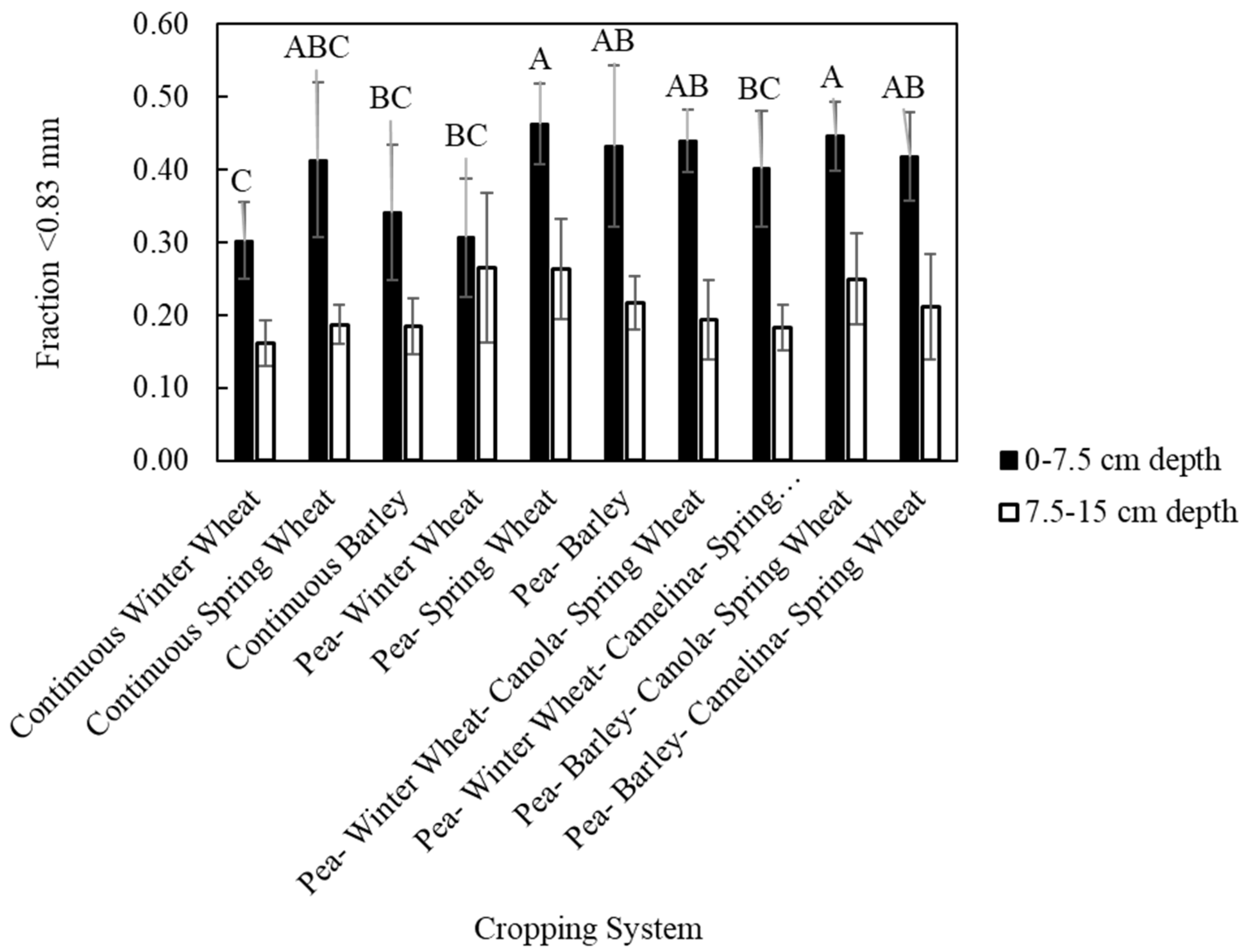
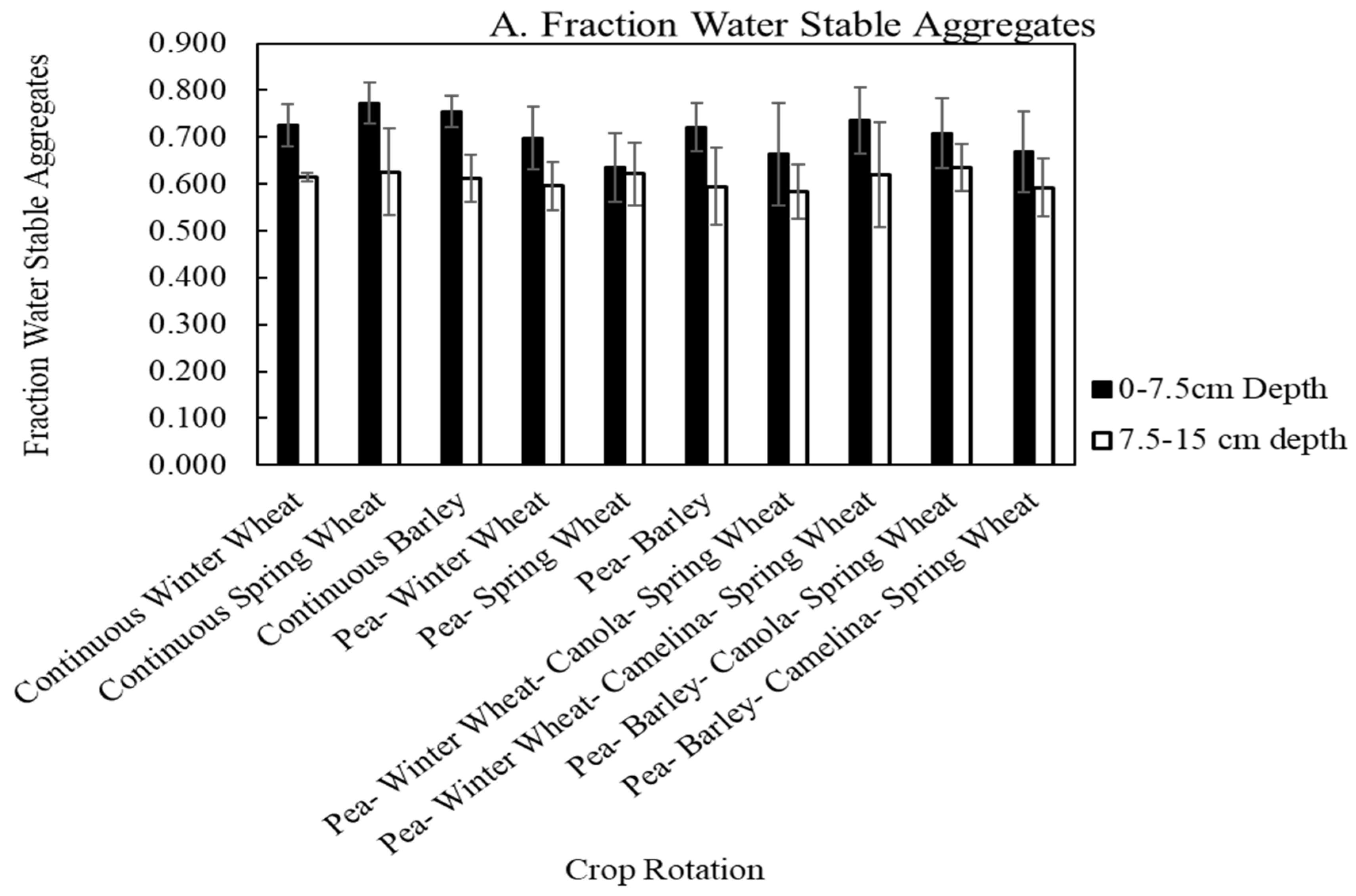
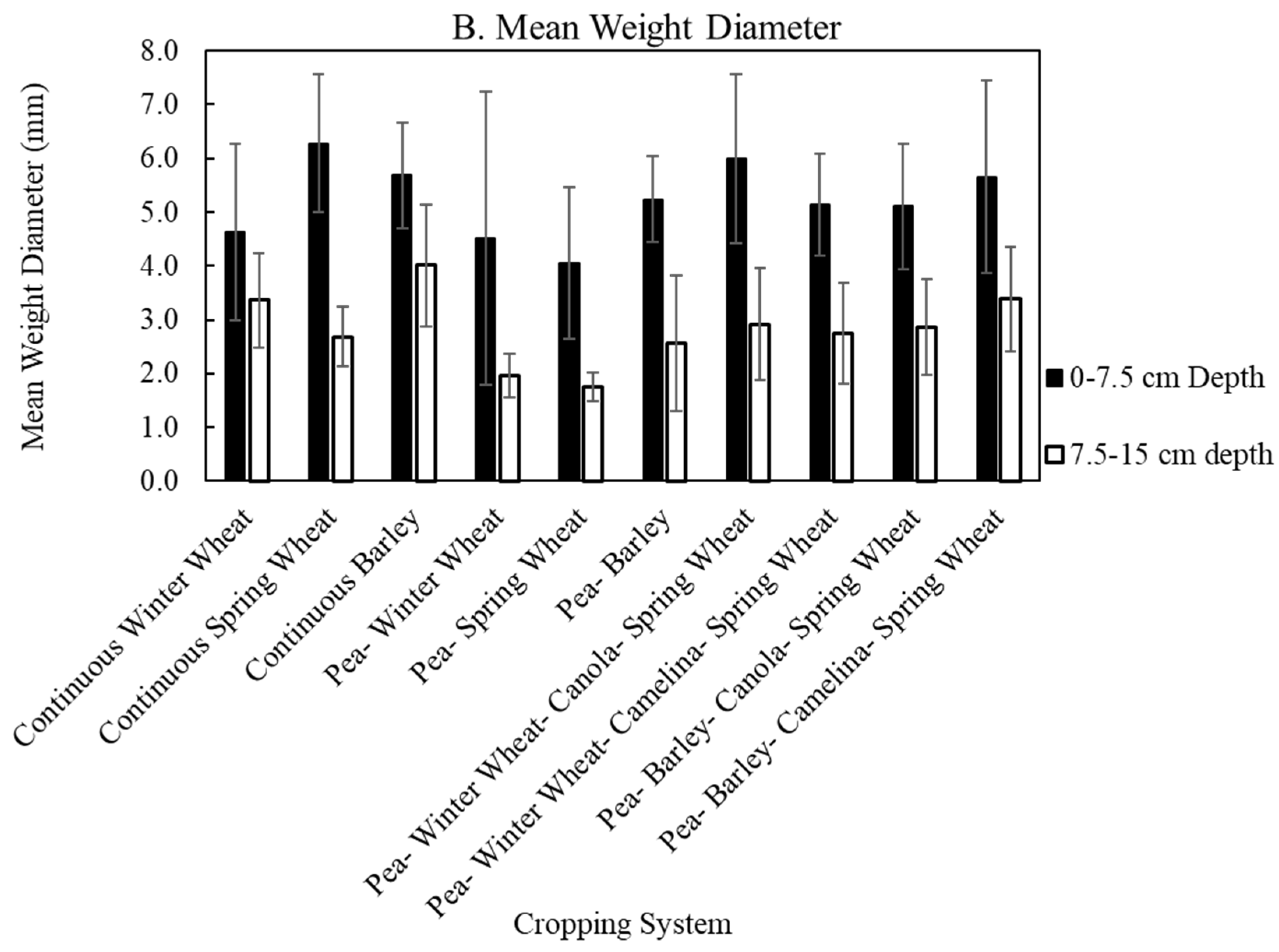
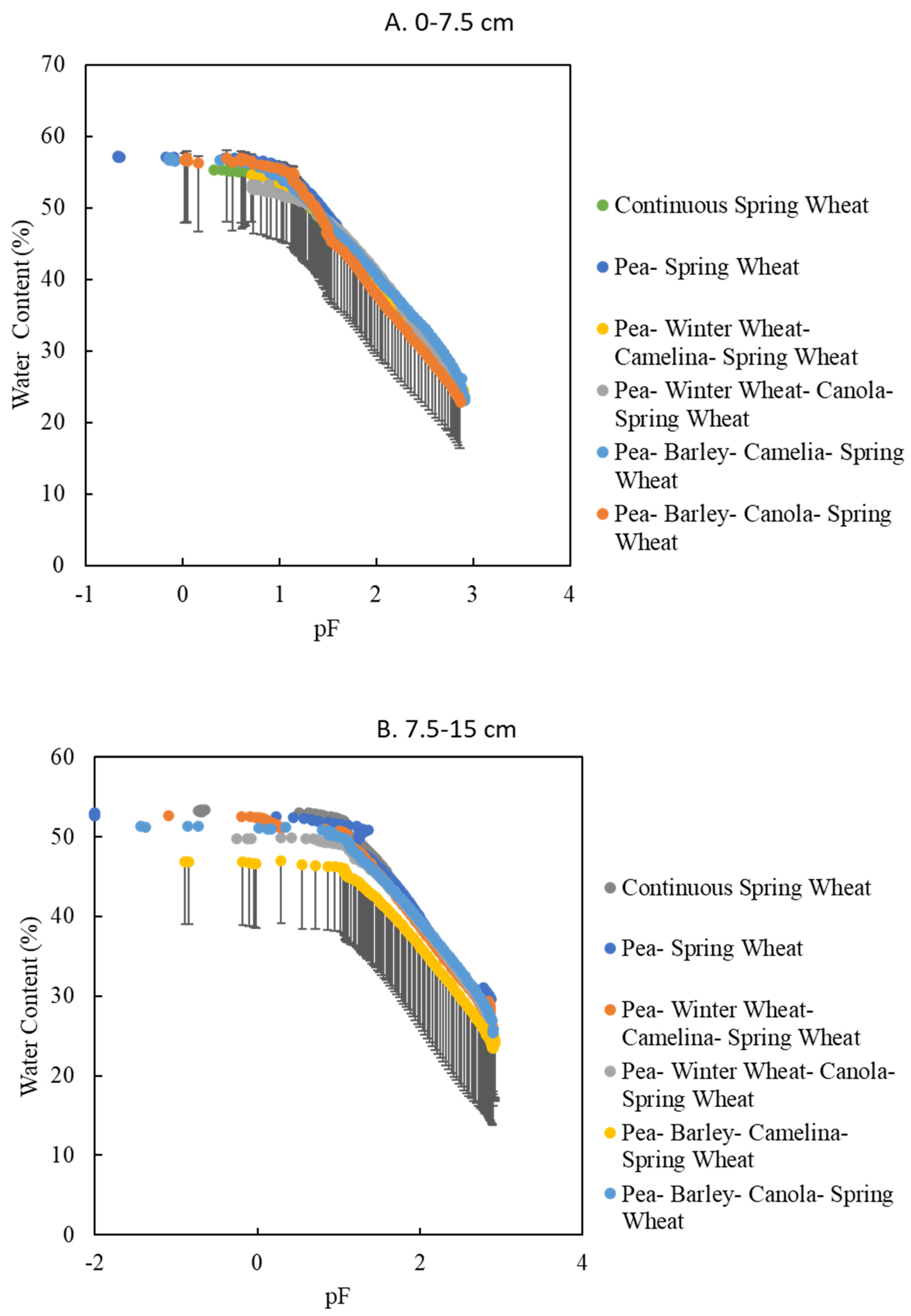
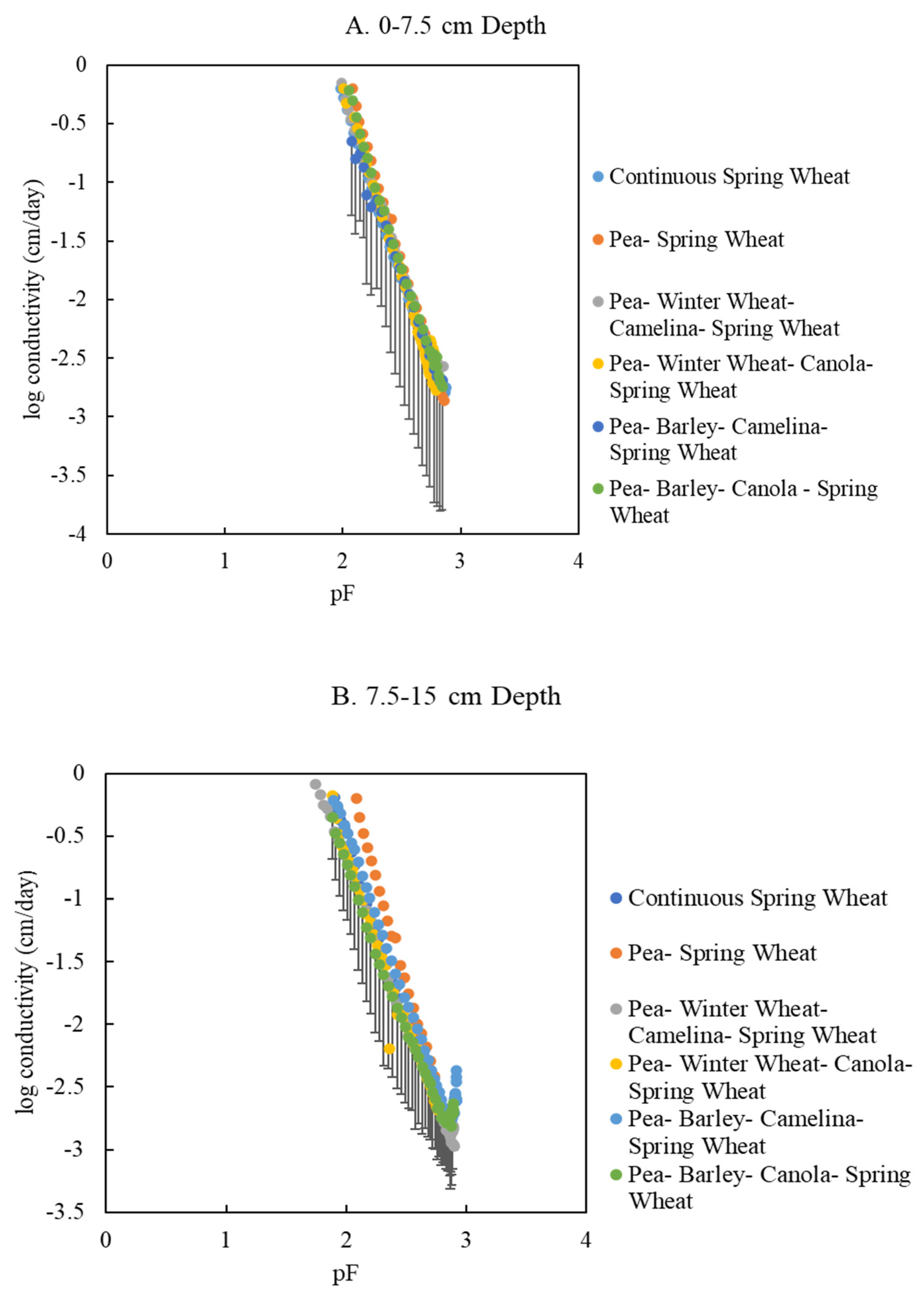

| Crop | Spring Wheat | Winter Wheat | Barley | Field Pea | Canola | Camelina |
|---|---|---|---|---|---|---|
| Year | Planting Date | |||||
| 2014 | 4/24 | 9/24/2013 | 4/25 | 4/22 | 4/25 | 4/25 |
| 2015 | 4/16 | 9/17/2014 | 4/16 | 4/14 | 4/15 | 4/15 |
| 2016 | 4/9 | 9/18/2015 | 4/9 | 4/11 | 4/9 | 4/9 |
| 2017 | 4/17 | 9/14/2016 | 4/17 | 4/15 | 4/18 | 4/18 |
| 2018 | 5/5 | 9/22/2017 | 5/5 | 5/5 | 5/7 | 5/7 |
| 2019 | 4/16 | 9/12/2018 | 4/16 | 4/15 | 4/16 | 4/16 |
| 2020 | 4/28 | 9/27/2019 | 4/28 | 4/28 | 4/28 | 2/28 |
| 2021 | 4/29 | 9/15/2020 | 4/29 | 4/29 | 4/30 | 4/30 |
| Harvest Date | ||||||
| 2014 | 8/14 | 8/14 | 8/14 | 8/29 | 7/28 | 7/22 |
| 2015 | 8/18 | 7/24 | 8/19 | NH | 8/13 | 8/4 |
| 2016 | 8/15 | 7/21 | 8/2 | 7/19 | 8/1 | 7/19 |
| 2017 | 8/1 | 7/14 | 7/31 | 7/16 | 7/31 | 7/25 |
| 2018 | 8/15 | 7/25 | 8/9 | 7/26 | 8/7 | 8/3 |
| 2019 | 8/15 | 7/30 | 8/16 | 7/31 | 8/16 | 7/31 |
| 2020 | 8/11 | 8/10 | 8/6 | 7/29 | 8/11 | 8/12 |
| 2021 | 8/12 | 8/11 | 8/11 | 7/27 | 7/26 | 7/21 |
| Cropping System | >8 mm | 4.75–8 mm | 2–4.75 mm | 0.25–2 mm | <0.25 mm | MWD | GMD |
|---|---|---|---|---|---|---|---|
| Units | Fraction Size | mm | |||||
| 0–7.5 cm Depth | |||||||
| Continuous Winter Wheat | 0.182 A | 0.041 | 0.255 BC | 0.407 | 0.115 c | 4.375 A | 3.241 |
| Continuous Spring Wheat | 0.092 B | 0.039 | 0.223 AB | 0.467 | 0.177 ab | 2.776 B | 3.031 |
| Continuous Barley | 0.239 A | 0.044 | 0.164 BC | 0.414 | 0.137 bc | 4.726 A | 3.720 |
| Pea–Winter Wheat | 0.148 B | 0.042 | 0.252 AB | 0.432 | 0.124 c | 3.813 B | 3.374 |
| Pea–Spring Wheat | 0.138 B | 0.039 | 0.167 BC | 0.452 | 0.17 a | 3.288 B | 2.704 |
| Pea–Barley | 0.074 B | 0.043 | 0.234 AB | 0.460 | 0.202 a | 2.573 B | 2.857 |
| Pea–Winter Wheat–Canola–Spring Wheat | 0.095 AB | 0.035 | 0.204 BC | 0.477 | 0.188 ab | 3.007 B | 2.725 |
| Pea–Winter Wheat–Camelina–Spring Wheat | 0.095 B | 0.047 | 0.251 A | 0.467 | 0.162 ab | 2.403 B | 2.907 |
| Pea–Barley–Canola–Spring Wheat | 0.068 B | 0.037 | 0.222 AB | 0.485 | 0.187 a | 2.802 B | 2.713 |
| Pea–Barley–Camelina–Spring Wheat | 0.117 B | 0.073 | 0.187 BC | 0.445 | 0.176 ab | 4.342 B | 3.018 |
| 7.5–15 cm Depth | |||||||
| Continuous Winter Wheat | 0.374 A | 0.048 | 0.257 BC | 0.256 | 0.065 | 7.322 A | 3.827 |
| Continuous Spring Wheat | 0.182 B | 0.077 | 0.360 AB | 0.312 | 0.069 | 5.618 B | 4.239 |
| Continuous Barley | 0.285 A | 0.065 | 0.278 BC | 0.305 | 0.067 | 5.321 A | 3.764 |
| Pea–Winter Wheat | 0.132 B | 0.063 | 0.306 AB | 0.396 | 0.102 | 3.677 B | 3.634 |
| Pea–Spring Wheat | 0.158 B | 0.074 | 0.290 BC | 0.373 | 0.104 | 3.736 B | 3.708 |
| Pea–Barley | 0.093 B | 0.045 | 0.365 AB | 0.425 | 0.072 | 3.559 B | 3.494 |
| Pea–Winter Wheat–Canola–Spring Wheat | 0.248 AB | 0.070 | 0.293 BC | 0.321 | 0.068 | 5.772 B | 4.059 |
| Pea–Winter Wheat–Camelina–Spring Wheat | 0.119 B | 0.065 | 0.399 A | 0.348 | 0.068 | 3.361 B | 4.026 |
| Pea–Barley–Canola–Spring Wheat | 0.123 B | 0.050 | 0.338 AB | 0.389 | 0.098 | 3.776 B | 3.591 |
| Pea–Barley–Camelina–Spring Wheat | 0.180 B | 0.063 | 0.326 BC | 0.357 | 0.075 | 5.278 B | 3.756 |
| Statistical Significance | |||||||
| Cropping System | 0.0005 | NS | 0.0152 | 0.0624 | 0.0058 | 0.0006 | NS |
| Depth | 0.0023 | 0.0030 | 0.0001 | 0.0001 | 0.0001 | 0.0001 | 0.0001 |
| Cropping System × Depth | NS | NS | NS | NS | 0.0500 | NS | NS |
| Replication | 0.0354 | 0.0005 | NS | 0.0014 | 0.0001 | 0.0186 | 0.0345 |
| Treatment | α | n | θr | θs | Ks | τ | 1.8 | 2.5 | 4.2 | Bulk Density |
|---|---|---|---|---|---|---|---|---|---|---|
| Units | cm−1 | cm3 cm−3 | cm3 cm−3 | cm Day−1 | % Water Content | g cm−3 | ||||
| Cropping System Effect | ||||||||||
| Spring Wheat | 0.038 | 1.292 | 0.069 | 0.550 | 670.7 | −0.819 | 42.5 | 31.0 | 15.4 | 1.38 |
| Pea-Barley-Camelina-Spring Wheat | 0.032 | 1.311 | 0.043 | 0.513 | 124.3 | −1.86 | 40.4 | 29.0 | 13.3 | 1.44 |
| Pea-Barley-Canola-Spring Wheat | 0.037 | 1.372 | 0.106 | 0.546 | 505.1 | −2.00 | 41.9 | 30.7 | 17.4 | 1.42 |
| Pea-Winter Wheat-Camelina-Spring Wheat | 0.037 | 1.399 | 0.136 | 0.539 | 1279.2 | −1.72 | 42.4 | 31.2 | 18.6 | 1.43 |
| Pea-Winter Wheat-Canola-Spring Wheat | 0.033 | 1.270 | 0.043 | 0.530 | 1428.3 | 0.628 | 43.2 | 32.3 | 15.2 | 1.47 |
| Pea-Spring Wheat | 0.0367 | 1.327 | 0.085 | 0.555 | 276.2 | −1.77 | 44.1 | 32.5 | 17.7 | 1.42 |
| Depth Effect | ||||||||||
| 0–7.5 | 0.042 a | 1.317 | 0.059 | 0.568 a | 1256.3 | −1.23 | 42.9 | 30.6 | 14.4 b | 1.32 b |
| 7.5–15 | 0.029 b | 1.340 | 0.102 | 0.510 b | 9.00 | −1.29 | 41.9 | 31.7 | 18.1 a | 1.54 a |
| Statistical Significance | ||||||||||
| Cropping System | NS | NS | NS | NS | NS | NS | NS | NS | NS | NS |
| Depth | 0.0130 | NS | 0.0894 | 0.0001 | 0.0794 | NS | NS | NS | 0.0108 | 0.0001 |
| Cropping System × Depth | NS | NS | NS | NS | NS | NS | NS | NS | NS | NS |
| Replication | 0.028 | NS | NS | NS | 0.0297 | 0.0137 | NS | NS | NS | 0.085 |
Disclaimer/Publisher’s Note: The statements, opinions and data contained in all publications are solely those of the individual author(s) and contributor(s) and not of MDPI and/or the editor(s). MDPI and/or the editor(s) disclaim responsibility for any injury to people or property resulting from any ideas, methods, instructions or products referred to in the content. |
© 2023 by the authors. Licensee MDPI, Basel, Switzerland. This article is an open access article distributed under the terms and conditions of the Creative Commons Attribution (CC BY) license (https://creativecommons.org/licenses/by/4.0/).
Share and Cite
Klopp, H.W.; Jabro, J.D.; Allen, B.L.; Sainju, U.M.; Stevens, W.B.; Dangi, S.R. Does Increasing the Diversity of Small Grain Cropping Systems Improve Aggregate Stability and Soil Hydraulic Properties? Agronomy 2023, 13, 1567. https://doi.org/10.3390/agronomy13061567
Klopp HW, Jabro JD, Allen BL, Sainju UM, Stevens WB, Dangi SR. Does Increasing the Diversity of Small Grain Cropping Systems Improve Aggregate Stability and Soil Hydraulic Properties? Agronomy. 2023; 13(6):1567. https://doi.org/10.3390/agronomy13061567
Chicago/Turabian StyleKlopp, Hans W., Jay D. Jabro, Brett L. Allen, Upendra M. Sainju, William B. Stevens, and Sadikshya R. Dangi. 2023. "Does Increasing the Diversity of Small Grain Cropping Systems Improve Aggregate Stability and Soil Hydraulic Properties?" Agronomy 13, no. 6: 1567. https://doi.org/10.3390/agronomy13061567
APA StyleKlopp, H. W., Jabro, J. D., Allen, B. L., Sainju, U. M., Stevens, W. B., & Dangi, S. R. (2023). Does Increasing the Diversity of Small Grain Cropping Systems Improve Aggregate Stability and Soil Hydraulic Properties? Agronomy, 13(6), 1567. https://doi.org/10.3390/agronomy13061567







